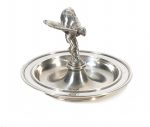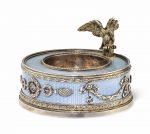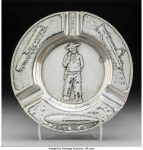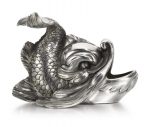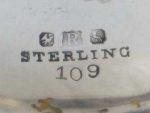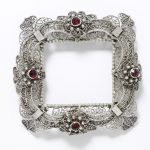The first examples of ashtrays probably date from around the early 19th Century. By the early 20th Century, ashtrays were more common and many different designs existed. The most popular ashtrays were made with glass but other materials such as silver and bakelite have also been used. After the First World War, it became fashionable for Ladies to smoke, especially for the flapper generation. This lead to a range of more feminine Ashtrays being made and these are among the most collectible today, due to their appealing nature.
For the gentlemen of the era, ashtrays tended to be larger and heavier, often made of marble or bronze. Other ashtrays depicted bronze statuettes such as Austrian Cold Painted Bronze animals mounted on marble ashtrays. These are collectible in their own right. Dutch Silver ashtrays often depict rural scenes making them very desirable.
A ROLLS-ROYCE STERLING SILVER ASHTRAY BY SEBASTIAN GARRARD & CO, PRESENTED AS A CHRISTMAS GIFT FOR 1926, hallmarked to underside of base, with central miniature Spirit of Ecstasy figure after the original design by Charles Sykes, 15cm diameter
Sold for € 1,750 (£ 1,531) inc. premium at Bonhams in 2017
A SILVER-GILT AND GUILLOCHÉ ENAMEL BELL-PUSH AND ASHTRAY BY FABERGÉ, WITH THE WORKMASTER’S MARK OF ANDREI GORIANOV, ST PETERSBURG, 1904-1908 Circular, enamelled in translucent pale blue over a wavy guilloché ground, the top centring a circular silver well with a beaded border, surmounted by a push-piece with a spread eagle-form finial, the sides mounted with ribbon-tied laurel swags and laurel wreaths and pine cones, all within leaf-tip chased borders, the base with later Russian dedication inscription dated 1927, marked under base 3 in. (7.6 cm.) diameter
Sold for GBP 5,250 at Christie’s in 2018
A Gorham Special Order Silver Cigar Ashtray with Pinkerton Detective Agency Motif, Providence, Rhode Island, circa 1920 Marks: GORHAM, (lion-anchor-G), STERLING, IDV 1/2 x 6-1/2 inches (1.3 x 16.5 cm) 4.29 troy ounces A round ashtray with three cigar rests between a repoussé train, submarine, and Zeppelin, and a repoussé masked figure pointing a gun accompanied by phrase “HANDS UP” based on the bandit in Pinkerton’s National Detective Agency advertisements.
Sold for $460 at Heritage Auctions in 2018
Ashtray, Eucalyptus blossoms, silver gilt / enamel, England, 1904-1914 Made in England, 1904-1914. Ashtray with shallow circular bowl on circular standing foot. Flat out turned bowl rim supports ‘U’ section sheet metal cigarette holder. Fabricated in silver, gilt with stamped champleve recess for tranparent milky green enamel over basse-taille engraved concave base metal of bowl interior and groove in rim. Surface of enamel in bowl is painted in opaque white, grey, green, browns enamel with eucaplyptus blossoms, buds. leaves and stems. Machine engraved basse-taille base beneath enamel displays a triple line ripple pattern running concentrically around inside of bowl.
Reference: Museum of Applied Art and Sciences
Dish 1934 Arthur Stone (American, born in England, 1847–1938)
The shallow spun dish with applied foot has chased trumpet flowers encircling its center. Identified as ashtrays, such small shallow dishes were often engraved with a wide assortment of floral decoration. Those made after 1926 usually do not have a craftsman’s initial, perhaps because the form was spun and Stone executed the simple ornament.
Reference: Museum of Fine Arts Boston
A Fabergé silver ashtray, Workmaster Julius Rappoport, St Petersburg, 1899-1904 cast and chased as a stylised open-mouthed dolphin, struck with workmaster’s initials and Fabergé in Cyrillic beneath the Imperial warrant, 88 standard, scratched inventory number 9023 or 9028 length 12.4cm, 4 7/8 in.
Sold for 35,000 GBP at Sothebys in 2017
